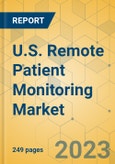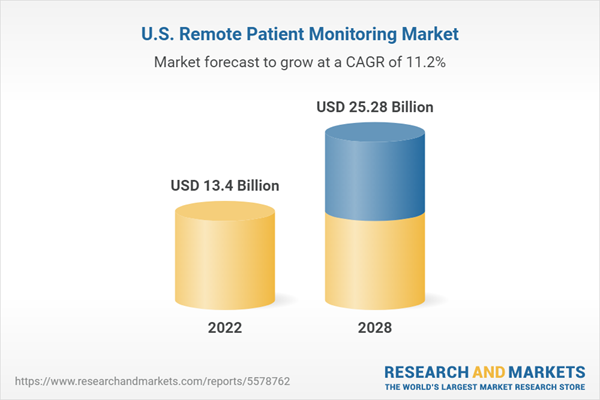Speak directly to the analyst to clarify any post sales queries you may have.
MARKET TRENDS & DRIVERS
Advances in Remote Patient Monitoring Technology
The COVID-19 pandemic has accelerated the growth of the U.S. remote patient monitoring market and has caught the attention of many medical professionals. Recently, IoT-enabled monitoring devices have added offering more functionalities to RPM. By combining AI with the Internet of Things (IoT) and RPM, healthcare organizations and practitioners can better serve their patients and provide opportunities for improved healthcare outcomes.Increasing Demand for Wireless Patient Monitoring at Home
Over the last few years, home patient monitoring has become a standard of care among adult patients that require a long-term alternative to hospital-based care. The trend toward using a wireless patient monitoring system to monitor vital signs continues to grow. Among many benefits being brought to the healthcare service by wireless patient monitoring is the facility to escalate home care for both chronic and acute conditions. The emergence of new technologies and capabilities makes taking care of one at home possible.Increasing Focus on Developing Software & Apps for RPM by Manufacturers
Increasing focus on developing software and apps specifically for remote patient monitoring (RPM) by manufacturers is an innovative way to improve and simplify the management of health conditions in both private and public healthcare settings. This ensures that care providers have access to accurate and secure data collected from patients tracked remotely through wearables and connected devices. Manufacturers in the U.S. remote patient monitoring market are investing in this trend by creating apps and software solutions that offer customizable and secure data-driven solutions for RPM. These solutions range from automated patient feedback protocols to machine learning algorithms that better track patient data and behavior. Manufacturers are also offering user-friendly and secure ways for care providers to access more accurate patient data and make informed decisions based on the data. This is creating a new landscape of both secure and efficient RPM services.The Growing Use of RPM to Monitor & Improve Patient Engagement
Remote patient monitoring (RPM) uses technology to collect, transmit, and review patient-generated data outside the traditional medical care setting. It allows healthcare providers to remotely monitor patients and gain insight into their physical state without having them physically present for a physical check-up. RPM can also detect changes in a patient's condition before they become obvious to the patient and help healthcare providers provide better, more personalized, and timely care. Through RPM, healthcare providers can keep track of patients' medical conditions in real-time and monitor them from a distance. It enables clinicians to identify potentially serious illnesses early and intervene with appropriate treatment. RPM can lead to better outcomes, improved patient engagement, and fewer hospitalizations. RPM also reduces healthcare costs by providing earlier treatment and better managing chronic conditions. Patients benefit from quality care while remaining in their homes with improved access to care and an enhanced overall care experience.Growing Use of Mobile Technologies & Smart Devices in RPM
Remote patient monitoring uses smartphones, tablets, and other devices to track patient health information constantly. It enables healthcare providers to track a wide range of vital signs such as heart rate, blood pressure, respiratory rate, and body temperature, allowing them to monitor patients from the comfort of their homes. With the growing use of mobile technology, remote patient monitoring can be done on the go. This improves access to care for remote populations and increases efficiency in healthcare delivery. Additionally, it enables real-time remote monitoring of those with chronic illnesses, allowing for timely intervention to prevent further health complications. Mobile technology also ensures data accuracy and consistency, which is critical for effective decision-making and patient care.SEGMENTATION INSIGHTS
INSIGHTS BY COMPONENT
The U.S. remote patient monitoring market by component is segmented into services, devices & software. In 2022, the software segment accounted for the largest share of the market. Service in the remote patient monitoring market involves using telemetric technology to monitor and collect patient health data from a remote location. This technology allows medical professionals to monitor their patient's health without requiring them to enter a physical medical facility. These services provide access to real-time patient health data, such as blood pressure, blood glucose levels, body temperature, and heart rate. In addition, telemetry technology can also be used to send alerts if an unusual change in vital signs is detected, allowing medical professionals to intervene quickly. This technology allows medical professionals to provide the best care for patients while they are away from the hospital and allows for earlier interventions when needed.Segmentation by Component
- Services
- Devices & Software
INSIGHTS BY APPLICATION
The cardiovascular diseases application segment held the largest U.S. remote patient monitoring market share in 2022, accounting for over 39%. According to the Centers for Disease Control and Prevention (CDC), approximately 11 million patients in the US suffer from cardiac dysrhythmia or arrhythmias. An increase in the prevalence of cardiovascular diseases (CVDs) is one of the factors driving the demand for cardiac monitoring devices. Remote cardiac monitoring has become the norm for patients with heart diseases, especially using implantable cardiac devices. With easy access to real-time telemetry data, cardiologists can determine if a condition represents an emergency illness and create an essentially virtual hospital. In addition, a quarter of health agencies report that RPM reduces visits and readmissions to emergency rooms. Further, the increased use of remote cardiac monitors to improve the detection of hypertension has been the focus of intense research activity in recent years. Remote cardiac monitors provide a viable solution for detecting hypertension at home without cumbersome and intrusive devices and procedures.Segmentation by Application
- Cardiovascular Diseases
- Respiratory Diseases
- Diabetes
- Musculoskeletal Diseases
- Others
INSIGHTS BY END-USER
The U.S. remote patient monitoring market by end-user is segmented into hospitals, home healthcare settings, ambulatory care settings, and long-term care centers. The hospital's segment accounted for the largest share and dominated the segment. The U.S. healthcare system and hospitals plan to improve outcomes and reduce costs through remote patient monitoring (RPM) technology. Hospital settings dominate cardiac monitoring equipment and are the initial point of contact for patients with health challenges. Patients with a history of cardiac arrhythmia are typically treated in hospitals. For the monitoring of CVDs, hospitals have the most up-to-date machines and technology. Though healthcare practitioners are always looking for ways to reduce patients' time in the hospital, the COVID-19 epidemic has increased pressure on physicians to minimize contact time even more to avoid virus exposure. One method that healthcare practitioners are addressing this issue is through remote patient monitoring. By allowing doctors to monitor their patients outside the hospital or doctor's office, they can reduce patients' time in those settings without jeopardizing their health.Segmentation by End-User
- Hospitals
- Home Healthcare Settings
- Ambulatory Care Settings
- Long-term Care Centers
REGIONAL ANALYSIS
The southern region accounted for 41% of the U.S. remote patient monitoring market in 2022 and dominated the market. The use of remote patient monitoring in Texas has steadily increased over the past few years. This technology is now being implemented in healthcare organizations across the state to help monitor, manage, and provide patient care more efficiently and effectively. The emergence of remote patient monitoring technology and its steady increase in usage in Texas reflects the state's commitment to providing improved patient care. Remote patient monitoring has been instrumental in cutting costs, as it allows for fewer hospital and clinic visits, thus decreasing the likelihood of patient complications due to prolonged exposure and wait times in an unfamiliar setting.Segmentation by Region
- South
- Texas
- Florida
- Virginia
- Oklahoma
- New Mexico
- West
- California
- Colorado
- Nevada
- Montana
- Midwest
- Michigan
- Illinois
- Ohio
- Northeast
- New York
- Pennsylvania
- Massachusetts
COMPETITIVE LANDSCAPE
The U.S. remote patient monitoring market is in a state of intense competition. The industry includes providers of a range of products and services, from diagnosis and treatment to delivery of healthcare applications. Companies operating in this segment are continually forced to innovate and improve to gain a competitive edge. Over the past few years, the U.S. remote patient monitoring market has grown rapidly with the entry of new players and the widespread adoption of technological advances. The focus is shifting towards conquering and expanding the market share from smaller, more localized players to larger, national-scale players. This competition has led to market size, scope growth, and product diversification.Key Company Profiles
- AMD Global Telemedicine
- GE Healthcare
- Koninklijke Philips
- Medtronic
- ResMed
- Teledoc Health
- Vivify Health
Other Prominent Vendors
- 100-Plus
- Abbott
- ACL Digital
- Altumview
- Baxter
- Biobeat
- Biofourmis
- BIOTRONIK
- Boston Scientific
- Cardiologs
- Cardiomo
- CAREMINDr
- CareValidate
- Datos Health
- Dexcom
- Drägerwerk AG
- F.Hoffmann-La Roche
- GrandCare Systems
- Health Recovery Solutions
- Hinge Health
- Honeywell International
- iHealth Unified Care
- Intel
- iRhythm Technologies
- Limber Health
- Masimo
- MedM
- Medopad
- ModivCare
- NIHON KOHDEN
- OMRON
- OSI Systems
- OSPLabs
- Qardio
- Resideo Technologies
- Senseonics
- TeleMedCare
- Ventricle Health
- VitalConnect
- Vitls
- VivaLNK
KEY QUESTIONS ANSWERED:
- How big is the U.S. remote patient monitoring market?
- What is the growth rate of the U.S. remote patient monitoring market?
- What are the rising trends in the U.S. remote patient monitoring market?
- Which region holds the most significant U.S. remote patient monitoring market share?
- Who are the top players in the U.S. remote patient monitoring market?
Table of Contents
Companies Mentioned
- AMD Global Telemedicine
- GE Healthcare
- Koninklijke Philips
- Medtronic
- ResMed
- Teledoc Health
- Vivify Health
- 100-Plus
- Abbott
- ACL Digital
- Altumview
- Baxter
- Biobeat
- Biofourmis
- BIOTRONIK
- Boston Scientific
- Cardiologs
- Cardiomo
- CAREMINDr
- CareValidate
- Datos Health
- Dexcom
- Drägerwerk AG
- F.Hoffmann-La Roche
- GrandCare Systems
- Health Recovery Solutions
- Hinge Health
- Honeywell International
- iHealth Unified Care
- Intel
- iRhythm Technologies
- Limber Health
- Masimo
- MedM
- Medopad
- ModivCare
- NIHON KOHDEN
- OMRON
- OSI Systems
- OSPLabs
- Qardio
- Resideo Technologies
- Senseonics
- TeleMedCare
- Ventricle Health
- VitalConnect
- Vitls
- VivaLNK
Methodology
Our research comprises a mix of primary and secondary research. The secondary research sources that are typically referred to include, but are not limited to, company websites, annual reports, financial reports, company pipeline charts, broker reports, investor presentations and SEC filings, journals and conferences, internal proprietary databases, news articles, press releases, and webcasts specific to the companies operating in any given market.
Primary research involves email interactions with the industry participants across major geographies. The participants who typically take part in such a process include, but are not limited to, CEOs, VPs, business development managers, market intelligence managers, and national sales managers. We primarily rely on internal research work and internal databases that we have populated over the years. We cross-verify our secondary research findings with the primary respondents participating in the study.

LOADING...
Table Information
| Report Attribute | Details |
|---|---|
| No. of Pages | 249 |
| Published | June 2023 |
| Forecast Period | 2022 - 2028 |
| Estimated Market Value ( USD | $ 13.4 Billion |
| Forecasted Market Value ( USD | $ 25.28 Billion |
| Compound Annual Growth Rate | 11.1% |
| Regions Covered | United States |
| No. of Companies Mentioned | 48 |









